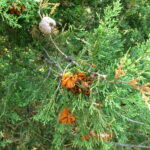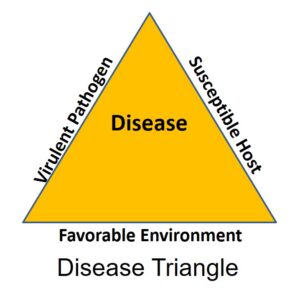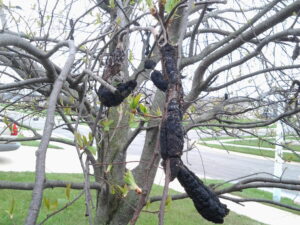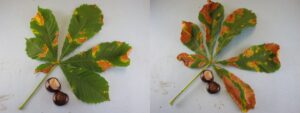
Figure 1. : Galls on juniper branches (sporulating galls with orange telial horns and older galls without horns) caused by the cedar apple rust pathogen, Gymnosporanium juniperi-virginianae.
Photo Credit: PPDL
How are your plant identification skills? Personally, without a reference, I tend to have difficulty identifying some of the less commonly used trees in the landscape. However, being a disease diagnostician/plant pathologist I do have a fallback strategy – the diseases. One of the key points here is some symptoms are so characteristic of, or some diseases are specific to, a small group of hosts that finding them can get you into the plant ID ballpark.
If you are looking at a cedar apple gall on an evergreen, you can deduce that it isn’t a pine or spruce, but a juniper and there is likely an apple tree not terribly far. If you are seeing large black, hard gall like structures on a tree, you are probably looking at a cherry or other Prunus spp. (Figure 2). If you aren’t sure if a tree is chestnut, horsechestnut, or hickory, but you are seeing severe Guignardia blotch, then you have been able to narrow it down to Aesculus sp. (Figure 3)!
- Figure 2. Black fungal galls on cherry associated with the disease black knot caused by Apiosporina morbosa. Photo Credit: John Woodmansee, Purdue Extension Educator, Whitley County
- Figure 3. Guignardia blotch symptoms on horsechestnut with typical, irregular blotches on affected leaves. Photo Credit: PPDL
Now this is typically a backwards situation for most of us working in the plant trade, but it illustrates an important point for diagnostics: knowing the plant host is half the battle.
In knowing the host, you know many pieces of information:
- How to identify it
- How it grows
- What is normal and healthy for that species
- Site conditions it prefers (pH, drainage, fertility, etc.)
- Winter hardiness for your area
- Cultural practices it can tolerate (shearing, dense planting, constructive pruning, etc.)
- Potential disease and insect pests
Being able to narrow the list of common problems to a handful is very important, especially when trying to diagnose a problem on-site, based on symptoms.

Figure 4. The disease triangle with the three required factors: a virulent pathogen, susceptible host, and favorable environment
Photo Credit: PPDL
The majority of diseases occur due to fulfilling the disease triangle – having three things (Figure 4):
- A susceptible host
- Conducive environmental conditions
- A virulent pathogen
While if you remove one of these sides of the triangle plant disease will not occur, it is important to realize that plant stress can drive or increase disease severity. Knowing how to make a particular plant happy, or at least avoiding major sources of stress, can help mitigate potential damage due to disease. Although, we are not experiencing drought conditions by meteorological data, we have shifted from the deluge to dryer weather. Drought stress, either caused by a true lack of water, or due to being planted at higher elevations (berms and slopes), is a common factor that leads to more severe symptoms in plants with cankers, fungal diebacks, and vascular diseases.
I am a plant pathologist and get excited when I see plant diseases. I don’t always identify plants “in the wild.” But when I do, it’s by their diseases. Stay hydrated my friends.

